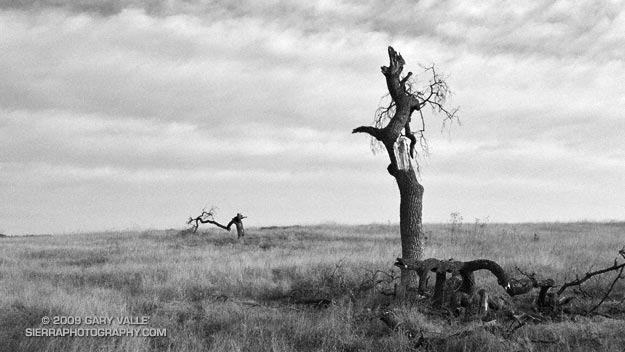
From a run at Ahmanson Ranch earlier this week.

From a run at Ahmanson Ranch earlier this week.
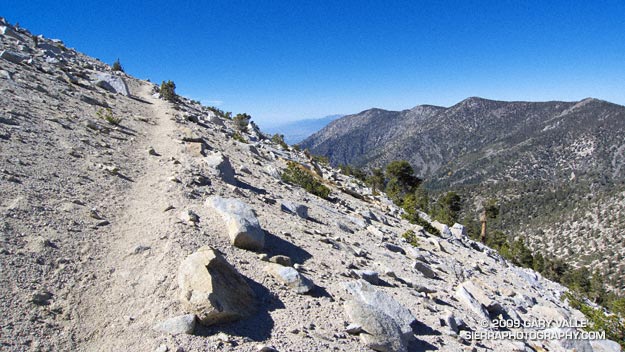
San Bernardino Mountain Divide from near Charlton Peak
As I approached the spur trail to High Meadow Springs, I tried to convince myself I had enough water to continue. The problem wasn’t the third of a mile detour down to the spring, or even the 280′ loss of elevation. The problem was the interruption. Having to get water was like having to stop to remove an annoying little rock from your shoe. You know you should, but one mile passes, then two… The running along the 10,500′ crest on the Divide Trail was just so spectacular, I didn’t want to stop!
I reached behind my back and squished the Camelbak reservoir with my hand. Yea, there’s plenty of water, I don’t have to stop. I can make it to the summit of Gorgonio, and then get water at High Camp on Vivian Creek on the way down.
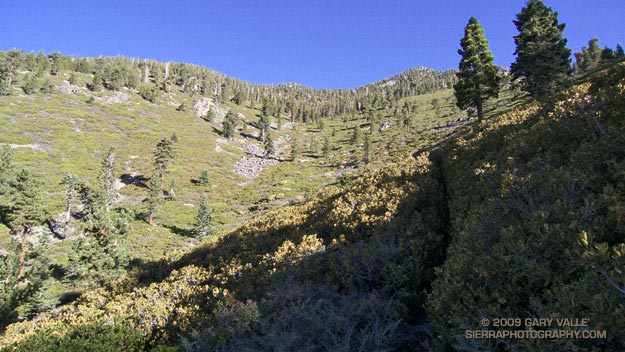
But hadn’t I nearly run out of water the last time I did this? I did a rough calculation of the distance… about four miles to the peak, with a gain of 1500′, and then another four miles to the creek. Reluctantly, I slowed, and turned off the Divide Trail
At the spring, I pulled the reservoir from my pack. Only about 25 oz. of water remained. The little spring burbled and gurgled energetically, and it didn’t take long to replenish my water supply. East of Shields Flat, the trail to High Meadow Springs is about a quarter-mile below the point marked 10,500 on the topo, and about half a mile above Red Rock Flat. At an elevation of 10,120′, the springs sit near the top of a steep canyon that drops down to Plummer Meadows. It’s an airy location with an expansive view.
Earlier, I had chugged up the Momyer Creek Trail to the San Bernardino Peak Divide Trail. Once past the turn to Alger Camp, this trail becomes more of a footpath, weaving its way through a middle elevation forest of pine and fir, around innumerable bark beetle felled Jeffrey pines, and up to a high mountain habitat of chaparral and Lodgepole pine.
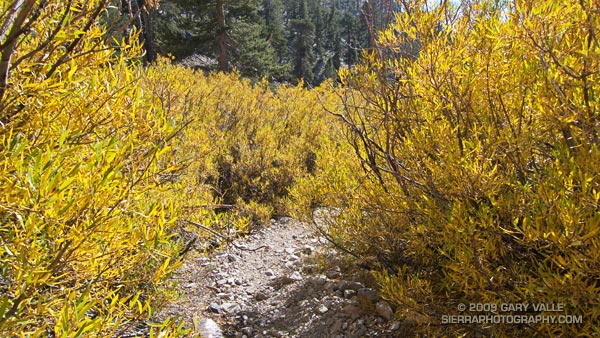
If stretches of trail with a 30% grade are not enough of a challenge, the last couple of miles to the divide include overgrown sections that will not only slow the shorts clad hiker or runner, but over time become annoyingly painful. Chinquapin is your friend, manzanita an adversary, and whitethorn your archenemy. And there is a lot of whitethorn.
After visiting High Meadow Springs, I continued down to Dollar Saddle. Beyond this point I expected to see an increasing number of hikers. The previous Saturday it had been exceptionally busy on Mt. San Jacinto, and the weather was even better today. Eventually, near Jepson Peak, I encountered a couple of hikers returning from the summit, and then passed a couple more working up the trail. But that was it — and the summit of San Gorgonio was empty. Unusual for such a perfect Autumn day.
Here’s a Cesium browser View of a GPS trace of the 26 mile route, and an elevation profile generated by SportTracks. The approximate elevation gain and loss was about 7000′.
Related post: San Gorgonio High Line, San Gorgonio Mountain – Falls Creek Loop
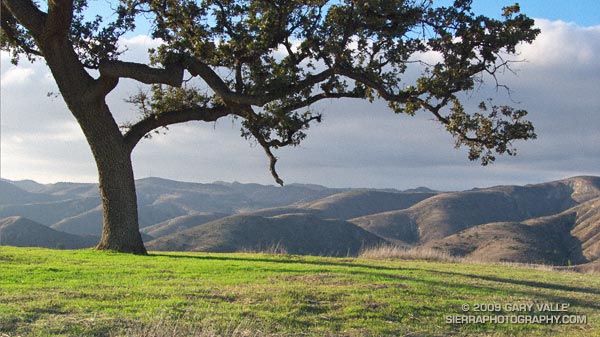
Less than a week after the rain in Southern California, grasses and other annuals are sprouting, and open space areas are starting to turn green.
From a run at Ahmanson Ranch this afternoon.
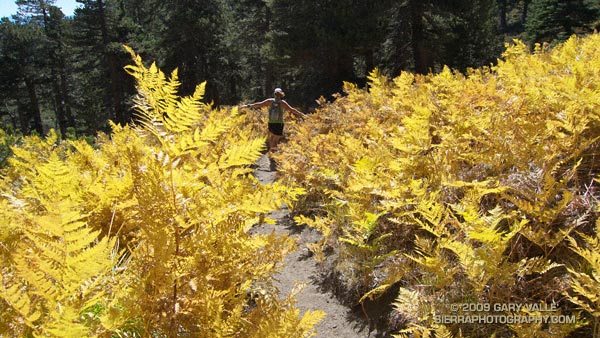
Spectacular Autumn trail running along Wellman Cienega in the San Jacinto Wilderness.
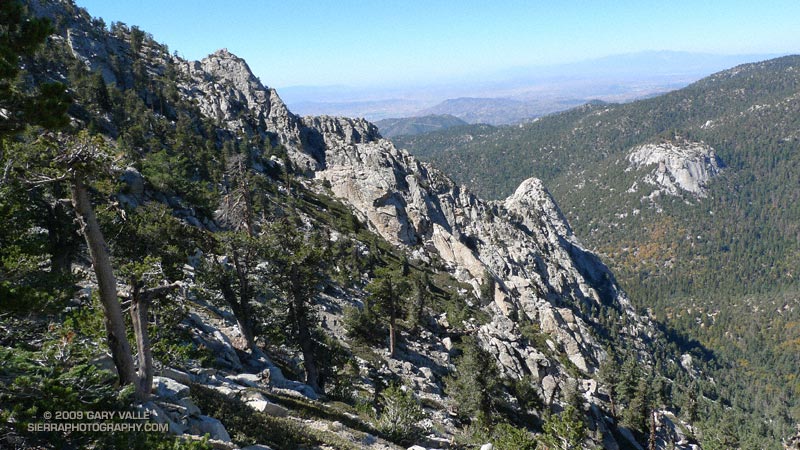
Lush with ferns and corn lilies in the summer, Wellman Cienega is a mountain seep high on the eastern slopes of Marion Mountain. It’s a couple of miles into an excellent 5 mile downhill segment from the top of San Jacinto to Saddle Junction.
From today’s trail run to San Jacinto Peak (10,834′) and Tahquitz Peak (8828′) from the top of the Palm Springs Tram at Long Valley.
Here’s a Cesium browser View of a GPS trace of the route, and an elevation profile generated in SportTracks. The total elevation gain/loss on the 20 mile run was about 4000′.
Related post: Room with a View

The first day of sun following rain on Tuesday and Wednesday. Ahmanson Ranch was not nearly as wet and muddy as I expected, and although water was pooled in Las Virgenes Creek, the stream was not running. Would have been a very different scenario had this storm occurred later in the rain season. Some rain totals for the Los Angeles area and comments about the developing El Nino are in my October Weathernotes.
The soft trail conditions were nearly ideal for barefoot running, and I took my running shoes off part way through the run. The muddy sections were great fun, and running barefoot was a enjoyable way to put a wrap on the rain event. I can’t wait for it to rain again!
The grass backlit by the sun is smilo (Piptatherum miliaceum). Introduced into California over a century ago, smilo is a drought resistant grass that has been used for pasture, and for erosion control following fires.
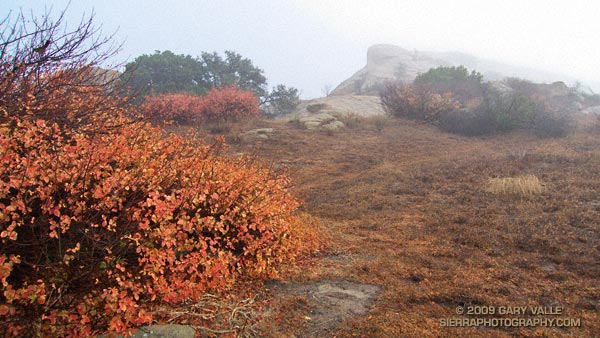
Did an enjoyable run at Sage Ranch today that started and ended in showers, but also included a few moments of subdued sun.
The shrub with the yellow-orange leaves is rain soaked poison oak. As I took the photo, a California towhee landed in its limbs, probably a little concerned about the unexpected house guest. From a towhee point of view, a thick chaparral shrub is a homey place with all of the creature comforts.
In chaparral areas towhees are common, and I frequently see them on my runs. Over years of running I’ve learned some of their habits.
Many times when I encounter a towhee on the trail, it will flutter and scurry along the ground just ahead of me, and then dart into a bush. Although not as dramatic as the broken wing act of a killdeer, this “catch me if you can” behavior is probably intended to draw a potential predator away from the bird’s nesting and living area.
Very different animals will often cooperate to benefit each other. In the case of a towhee, one of its best buds is apparently the cottontail rabbit. On occasion I will see the bird and rabbit foraging together on a trail. When trying to keep a wary eye out for potential predators, four eyes are much better than two.
Where there is one towhee, there will often be another nearby — presumably its mate. At Sage Ranch, I’ve repeatedly encountered a pair of towhees near a particular shrub over a period of several years.